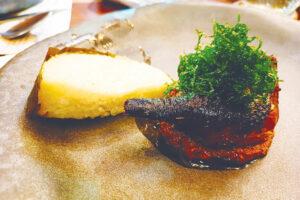BUSINESSWORLD popped in on the second day of the Tagaytay Food Festival, which ran from July 18 to 20 mainly at the Tagaytay Vista Hotel. While inclement weather canceled events such as off-site tours, the frightening rains served as a canvas for chefs Jay Jay and Rhea Sycip of The Fatted Calf (a cult Tagaytay favorite worth the drive) and their collaborator for the evening, Hafizzul Hashim of the one Michelin-starred Restaurant Fiz in Singapore. All three presented a vision of comfort food across these seas, with the theme “Food that Binds.”
The food served did not give us comfort — what it did give us was a sense of euphoria.
Perhaps it was the generous servings, the sheer amount of dishes (we lost count after 10) stretching our stomachs, or just that the food made us feel so good, we reached a level of cheer that could be described as akin to a runner’s high.
The restaurant was noisy that evening, so much so that some couldn’t tell it was still raining if not for the raindrops tinkling against the skylight. Someone at our table read kinky love letters from James Joyce, also from the food-borne euphoria.
The dinner started calmly enough with a rondeau of amuse bouches, including Fried Siopao, Fish Tartlet, Kaya Toast with Caviar, and Crispy Fish Skin. Mr. Hashim bade us to eat that in a reversed order, so we had the fish skin first: frothy and light with smoked milkfish mousse. The Kaya Toast was a revelation: we didn’t realize that the common breakfast item in Singapore could reach such a luxurious height, but then how many people top this with caviar? The texture of the brioche toast contrasted with the creamy kaya while the caviar just gave a rarefied accent, without becoming vulgar with the expense. The Fish Tartlet, with kinilaw na papaya (ceviche, but using papaya instead), house pineapple vinegar, weaver ant salt, and kaffir lime oil, was delicate but interestingly muscular, with all the textures of the firm fish felt on the tongue.
A first course saw Rellenong Alimasag (stuffed crab), with a topping of turmeric custard and a crab fat emulsion. With lemon basil oil, it tasted very clean, despite the spiciness of the curry: the overall impression was a clear, sharp, white-hot flavor. It shared these characteristics with a Prawn Skewer with Sambal Tumis(fried chili paste; we encountered different versions of sambal during this dinner), but this prawn was more straightforward with its heat than the crab.
The chefs all worked on the Sinigang (sour soups), which they found they had in common. This version uses tomato, balmimbing (Averrhoa carambola or star fruit), alibangbang, (butterfly tree), and calamansi (a small native citrus) to sour the broth, and serves this with pansit-pansitan (a local herb) and dry-aged sea bream. The result was a sinigang that was earthier with a slight medicinal hint.
The main course was Mr. Hashim’s special pride, a Smoked Duck Leg Rendang (a coconut milk curry) with turmeric leaf. This had a side of glutinous rice cooked in bamboo (we had two; this might have been the straw that broke this camel’s stomach), Urap (a side dish with pako – ferns – and winged beans, toasted coconut, and another kind of sambal), cassava leaf in turmeric leaf-infused coconut sauce, and green chili sambal (Sambal Ijo). It was more than a mouthful, but we ate through all of it: it was lively, heavily nuanced, just exotic enough, but still strangely familiar.
Next, the chefs served duck again for their version of Tres Marias, a local Cavite trifecta often served for Sunday lunch. This had the Shio Koji dry-aged duck in a roasted rice sauce and duck fat-annatto oil (like kare-kare, a peanut-based stew); an adobo using Black Onyx brisket, house pili vinegar, and fermented black garlic. The third dish was a Papaya Kilawin with beef pancreas and topped with crispy ox tripe and ubod (heart of palm) miso. The Duck Kare-Kare was divine. The vegetables were wrapped in a leaf with flowers, which one breaks. It had an excellent lively flavor with just a hint of herbal, earthy indulgence. I could write sonnets about that duck, perfectly juicy but with an honest, straightforward taste.
We were much too full, and the rest of the evening passed in a haze, but we do remember a bite of the Kelapa, Bingka, and Itlog Maalat — coconut, bibingka (a rice cake), and salted egg, topped with mantecado (custard) ice cream. The richness was cut with the peppery flavor of fresh edible flowers.
The Sycip couple recalled meeting Mr. Hashim through fellow chef Waya Araos-Wijangco just this past summer. “Every time we got to see each other, we never stopped talking about ingredients,” said Mr. Sycip in a speech. “So many things, so many elements are the same.”
“We talk about food, the similarities of ingredients,” said Mr. Hashim. “We have a difference in cooking methods and cultural differences, yet the same root.”
In an interview, Ms. Sycip said, “We speak different languages, and yet we speak the same. We were able to connect through the food… it’s sharing stories.” — Joseph L. Garcia
